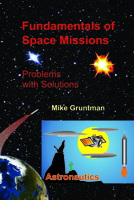 Spacecraft System Design
Spacecraft System Design
astronauticsnow.com/aste520
 Spacecraft System Design
Spacecraft System Design
ASTE 520
Department of Astronautical Engineering (ASTE)
Viterbi School of Engineering (VSOE)
University of Southern California (USC)
Master of Science in Astronautical Engineering (MS ASTE)
MS ASTE - Frequently asked questions
Mike's ASTE 575 Rocket and Spacecraft Propulsion (former ASTE 470)
who should take course ASTE 520 Spacecraft
Design  MS ASTE Program Update
MS ASTE Program Update
|
160+ problems with detailed solutions
|
 |
|
|
Space: From Firecrackers to Interstellar Flight
|
Analysis of satellite launch by North Korea in December 2012 and ballistic missile threat
|
Hole and leak at the International Space Station, August 2018
|
 Instructor:
Mike Gruntman
Instructor:
Mike Gruntman
Advanced degrees in astronautical engineering for the space industry,
Acta Astronautica, 2014

ASTE 520 in the Fall, 2025, semester:
all course materials will be posted
on the class web site at
DEN's D2L
in mid August.
One can get more information about the course
from the typical first (introductory and organizational) lecture (Fall 2025):
ASTE 520 – first lecture.
In 2025–2026 academic year, ASTE520 Spacecraft Design
will be offered in the Fall, 2025, semester
(Thursday, 6:40–9:20 pm);
the course is not offered
in the spring, 2026, semester.
In 2025–2026 academic year, ASTE520 Spacecraft Design
will be offered in the Fall, 2026, semester.
See astronautics
course schedule
Class enrollement is unlimited.
Note that shedules do change.
Always check the course schedule with
ASTE Student Advisor.
 Course
webcasts.
All lectures are available as webcasts through VSOE's
Distance Education Network DEN, D2L
to all (on-campus and remote)
students enrolled in the course during the entire semester.
Course
webcasts.
All lectures are available as webcasts through VSOE's
Distance Education Network DEN, D2L
to all (on-campus and remote)
students enrolled in the course during the entire semester.
ASTE-520 is a popular graduate course.
About Course ASTE 520
|
|
|
ASTE 520 Spacecraft System Design -- Course Outline
see also a recent first organizational lecture of the course for details)
Only for students enrolled in Mike's ASTE 520
Class Notes (800+ pages) are essential and mandatory for the course.
The notes are available for download at DEN's web site of
ASTE520 in the beginning of the semester.
 Alsways start with reading the "readme.pdf" file for the instructions.
Alsways start with reading the "readme.pdf" file for the instructions.
The full set of homework assignments will also be available in the beginning of the semester (at the latest, by the end of the first month of the semester).
To access the class web site at DEN, all students enrolled in the class (including all on-campus students) must register with DEN.
Note that the course notes are protected with a password that can be obtained only from the instructor (see Section 00, Part 2).
ASTE-520: Recommended textbooks
textbooks = recommended (none required); course notes = required
J. R. Wertz, D.F. Everett, and J.J. Puschell (eds), Space Mission Engineering: The New SMAD,
Microcosm, 2011
search the web for better prices, e.g., at Microcosm's bookstore at https://smad.com/
ISBN
9781881883159
W.J. Larson and J.R. Wertz (eds), Space Mission Analysis and Design
Kluwer Academic Publishers and Microcosm, 3rd Edition
ISBN 9781881883104.
P. Fortescue, G. Swinerd, J. Stark, Spacecraft Systems Engineering, Wiley, 2011
ISBN 9780470750124.
V. L. Pisacane, Fundamentals of Space Systems, Oxford Univ. Press, 2005 and other editions
ISBN 9780195162059.
M. Gruntman, Fundamentals of Space Missions: Problems with Solutions, Interstellar Trail Press, 2022
ISBN 9798985668742.
book details at http://astronauticsnow.com/fsm2022
Insist your institutional and local libraries get these books for you to use.
Many other textbooks and
monographs -- recommended by the instructor -- on
various aspects of astronautics, space technology, and space systems are listed at
http://astronauticsnow.com/AstroBooks/index.html
There are 30–36 homework assignments.
Late homework (up to 2 weeks) is graded with grades reduced by a 50%
factor.
Grading policy for ASTE 520 (subject to change)
Midterm exam = 40%
Final exam = 40%
Homework = 20%
Awarded (annual) Master's degrees in Astronautical Engineering

|
|
|